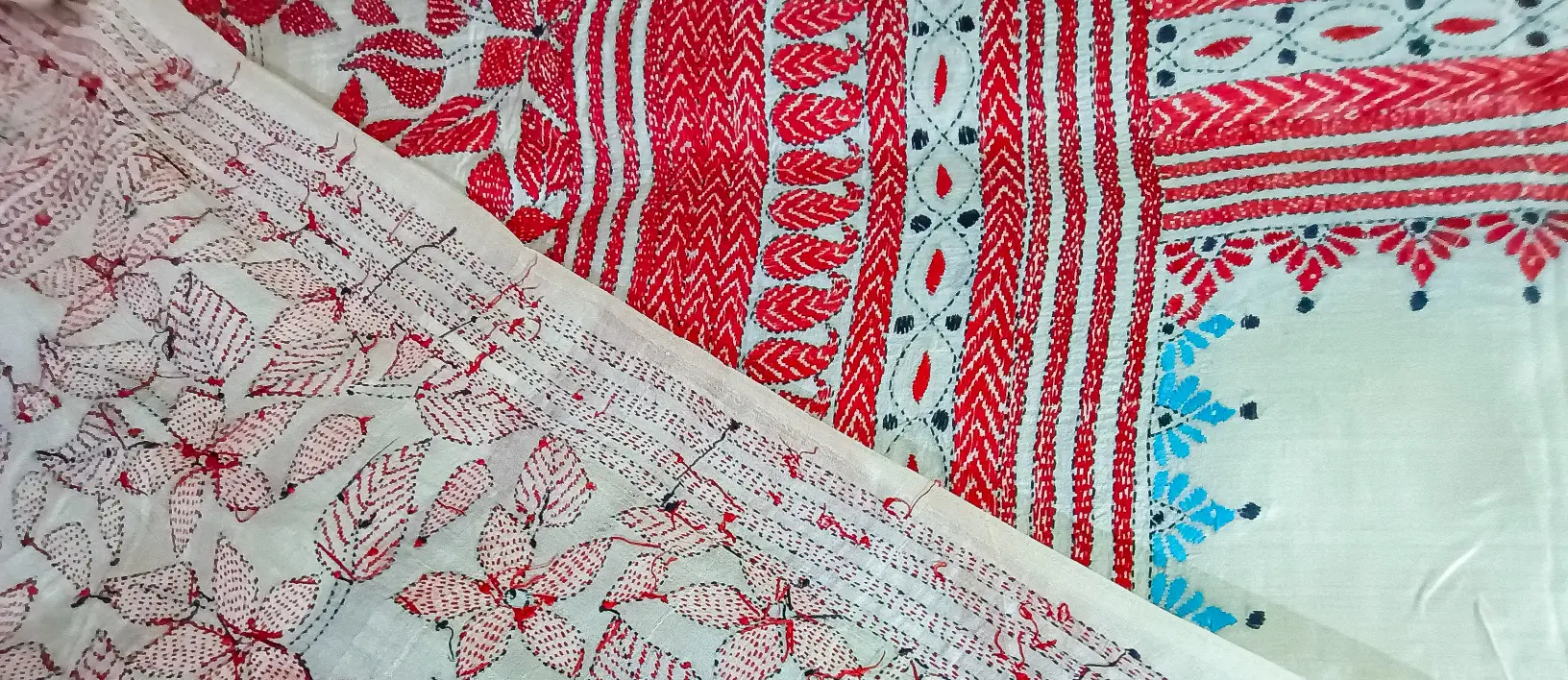THREADS OF TRADITION: UNRAVELING THE MAGIC OF KANTHA STITCH - THE BENGALI EMBROIDERY ART OF STORYTELLING
 Bengali Kantha Stitch, encompassing Kantha Embroidery, is an intricate craft rooted in Bengal's heritage. Traditional Kantha often tells a story through its design, depicting folklore, daily life, or cultural aspects.
Bengali Kantha Stitch, encompassing Kantha Embroidery, is an intricate craft rooted in Bengal's heritage. Traditional Kantha often tells a story through its design, depicting folklore, daily life, or cultural aspects. It involves hand-stitching exquisite patterns onto fabrics like Kantha Sari, resulting in Kantha Art that's both decorative and functional. This traditional Kantha Craft extends to creating Kantha Blankets, using Kantha Patterns on vintage textiles like Kantha Silk. With its rich history, Bengali Textiles showcase Kantha's unique appeal, seen in Kantha Decor, Kantha Handwork, and even Kantha Clothing. This Kantha Tradition blends artistry and heritage, seen in Kantha Embroidered pieces, Kantha Pillows, and more – a testament to Bengal's cultural Kantha Heritage and mastery in Traditional Kantha, Kantha Quilt, Kantha Applique, and Kantha Patchwork.
What is history of Kantha Stitch?
Kantha Stitch, an ancient art from Bengal, involves embroidering intricate patterns on old fabrics. Initially, it served to repurpose and mend textiles, later becoming a decorative art form reflecting the region's cultural heritage. Kantha stich got GI Tag from Govt. of India on 15th March 2021What are different types of Kantha Stitch you should collect?
Kantha Stitch encompasses various types, including:- Lep Kantha: Layered quilts with running stitch patterns.
- Sujani Kantha: Colorful quilts adorned with motifs.
- Baiton Kantha: Covers for valuables, featuring intricate designs.
- Archilata Kantha: Highly ornamental with gold and silver threads.
- Oaar Kantha: Narrative pieces illustrating stories.
- Durjani Kantha: Everyday use textiles with simple stitches.
- Bosal Kantha: Traditional seat and back covers.
- Oitijya Kantha: Depicting themes of social and cultural importance.
- Agniswar Kantha: Featuring fire motifs, symbolizing energy and purity.
- Rumal Kantha: Decorative handkerchiefs with delicate stitches.
What are materials used to create Kantha Stitch?
Kantha Stitch typically involves using materials such as:- Old Fabrics: Repurposing old saris, dhotis, and cloth pieces forms the base.
- Cotton Threads: Colored and contrasting threads are commonly used for stitching.
- Needles: Sharp needles facilitate intricate stitching.
- Backing Cloth: A fabric layer that supports the embroidered design.
- Batting: Soft padding placed between layers to add warmth and texture (for quilts).
- Design Templates: Stencils or freehand sketches guide the stitch patterns.
- Frames or Hoops: Holding the fabric taut for precise stitching.
- Embellishments: Sequins, beads, and mirrors may be added for extra decoration.
- Thimble: Protects fingers during stitching.
- Wax: Applied to the thread to make it smoother for stitching.
How to identify original kantha stich?
Genuine Kantha pieces show a similar pattern on the backside, as the stitches pass through the fabric layers.Imperfections: Handcrafted pieces may have slight irregularities, which add to their uniqueness. Machine-made items tend to have more consistent stitching.
Compare the piece with known authentic Kantha examples or images to identify similarities.
Authentic Kantha is associated with Bengal, India, so understanding the provenance can provide clues to its authenticity.



